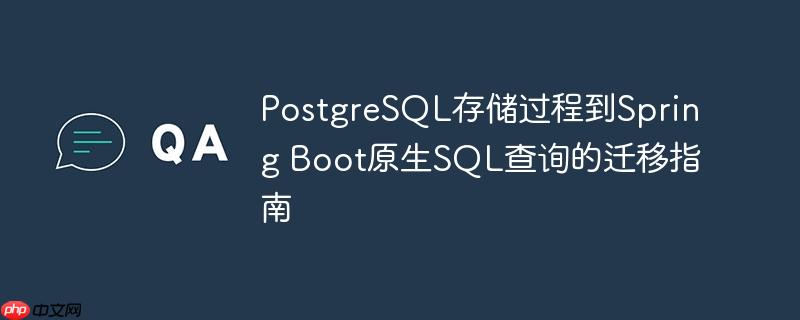
在现代应用开发中,尤其是在采用微服务架构和spring boot等框架时,将业务逻辑从数据库存储过程迁移到应用层是一种常见的实践。这种迁移有助于提高代码的可维护性、可测试性、可移植性,并允许开发者使用统一的编程语言(如java)来管理业务逻辑。本教程将以一个具体的postgresql存储过程为例,展示如何将其核心查询逻辑转换为spring data jpa可调用的原生sql查询。
我们首先分析原始的PostgreSQL存储过程spfetchowner:
CREATE OR REPLACE PROCEDURE public.spfetchowner(
owner integer,
optype integer,
INOUT p_refcur refcursor)
LANGUAGE 'plpgsql'
AS $BODY$
BEGIN
OPEN p_refcur FOR
SELECT
z.owner_num,
COALESCE(op_type_num, optype) AS op_type_num,
ad.sunday, ad.monday, ad.tuesday, ad.wednesday, ad.thursday, ad.friday, ad.saturday
FROM (SELECT owner AS owner_num) AS z
LEFT OUTER JOIN owner_details AS ad
ON z.owner_num = ad.owner_num AND op_type_num = optype;
END;
$BODY$;该存储过程接收两个输入参数:owner (整数类型) 和 optype (整数类型),以及一个INOUT类型的refcursor参数p_refcur,用于返回查询结果集。其核心逻辑是一个SELECT语句,执行以下操作:
查询涉及的owner_details表结构如下:
CREATE TABLE owner_details (
owner_num integer NOT NULL,
op_type_num integer NOT NULL,
sunday numeric(5,3),
monday numeric(5,3),
tuesday numeric(5,3),
wednesday numeric(5,3),
thursday numeric(5,3),
friday numeric(5,3),
saturday numeric(5,3),
CONSTRAINT pk_owner_details PRIMARY KEY (owner_num, op_type_num)
);存储过程的核心是OPEN p_refcur FOR SELECT ...中的SELECT语句。我们可以直接提取并修改这个SELECT语句,使其能够接收来自Java应用的参数。
原始SQL中的owner和optype是存储过程的输入参数。在转换为原生SQL时,它们将由Java方法传入的参数替代。
转换后的SQL查询结构如下:
SELECT
z.owner_num,
COALESCE(ad.op_type_num, :typeNum) AS op_type_num, -- :typeNum 替换了存储过程的 optype 参数
ad.sunday, ad.monday, ad.tuesday, ad.wednesday, ad.thursday, ad.friday, ad.saturday
FROM (SELECT :ownerNum AS owner_num) AS z -- :ownerNum 替换了存储过程的 owner 参数
LEFT OUTER JOIN owner_details AS ad
ON z.owner_num = ad.owner_num AND ad.op_type_num = :typeNum; -- :typeNum 替换了存储过程的 optype 参数请注意,COALESCE(op_type_num, optype)中的optype和ON z.owner_num = ad.owner_num AND op_type_num = optype中的op_type_num在LEFT OUTER JOIN的ON子句中,如果owner_details表中不存在匹配的行,ad.op_type_num将为NULL。然而,原始SP的意图是如果owner_details中找不到op_type_num,就使用传入的optype参数。在ON子句中,我们应该使用传入的参数typeNum来匹配。COALESCE的第二个参数也应是传入的typeNum。
Spring Data JPA允许通过@Query注解执行原生SQL查询。这里我们提供两种参数绑定方式。
命名参数通过@Param注解将Java方法参数映射到SQL查询中的命名占位符(例如:ownerNum)。这种方式提高了查询的可读性和可维护性,尤其是在参数较多时。
实体类 (OwnerDetails): 为了接收查询结果,需要一个与查询结果列对应的Java实体类。
import java.math.BigDecimal;
import jakarta.persistence.Entity;
import jakarta.persistence.Id;
import jakarta.persistence.Table;
import jakarta.persistence.Column;
// 假设 OwnerDetails 是一个JPA实体,或者是一个POJO,用于映射查询结果
// 如果是POJO,则不需要@Entity和@Id,但需要确保字段名与查询结果的别名匹配
@Entity // 如果OwnerDetails对应数据库表,并且是JPA实体
@Table(name = "owner_details") // 示例,实际可能不需要对应整个表
public class OwnerDetails {
@Id // 假设owner_num和op_type_num共同构成主键
@Column(name = "owner_num")
private Integer ownerNum;
@Id
@Column(name = "op_type_num")
private Integer opTypeNum;
private BigDecimal sunday;
private BigDecimal monday;
private BigDecimal tuesday;
private BigDecimal wednesday;
private BigDecimal thursday;
private BigDecimal friday;
private BigDecimal saturday;
// Getters and Setters
public Integer getOwnerNum() { return ownerNum; }
public void setOwnerNum(Integer ownerNum) { this.ownerNum = ownerNum; }
public Integer getOpTypeNum() { return opTypeNum; }
public void setOpTypeNum(Integer opTypeNum) { this.opTypeNum = opTypeNum; }
public BigDecimal getSunday() { return sunday; }
public void setSunday(BigDecimal sunday) { this.sunday = sunday; }
public BigDecimal getMonday() { return monday; }
public void setMonday(BigDecimal monday) { this.monday = monday; }
public BigDecimal getTuesday() { return tuesday; }
public void setTuesday(BigDecimal tuesday) { this.tuesday = tuesday; }
public BigDecimal getWednesday() { return wednesday; }
public void setWednesday(BigDecimal wednesday) { this.wednesday = wednesday; }
public BigDecimal getThursday() { return thursday; }
public void setThursday(BigDecimal thursday) { this.thursday = thursday; }
public BigDecimal getFriday() { return friday; }
public void setFriday(BigDecimal friday) { this.friday = friday; }
public BigDecimal getSaturday() { return saturday; }
public void setSaturday(BigDecimal saturday) { this.saturday = saturday; }
// Constructors, toString, equals, hashCode if needed
}Repository 接口:
import org.springframework.data.jpa.repository.JpaRepository;
import org.springframework.data.jpa.repository.Query;
import org.springframework.data.repository.query.Param;
import org.springframework.stereotype.Repository;
import java.util.Optional; // 推荐使用Optional处理可能无结果的情况
@Repository
public interface OwnerDetailsRepository extends JpaRepository<OwnerDetails, Integer> {
@Query(nativeQuery = true,
value = "SELECT " +
"z.owner_num, " +
"COALESCE(ad.op_type_num, :typeNum) AS op_type_num, " + // COALESCE的第二个参数使用传入的typeNum
"ad.sunday, ad.monday, ad.tuesday, ad.wednesday, ad.thursday, ad.friday, ad.saturday " +
"FROM (SELECT :ownerNum AS owner_num) AS z " +
"LEFT OUTER JOIN owner_details AS ad " +
"ON z.owner_num = ad.owner_num AND ad.op_type_num = :typeNum") // ON子句也使用传入的typeNum
Optional<OwnerDetails> fetchOwnerDetailsByOwnerNumAndOpType(
@Param("ownerNum") Integer owner,
@Param("typeNum") Integer type);
}注意事项:
序号参数通过?1, ?2等占位符,按照方法参数的顺序进行绑定。
Repository 接口:
import org.springframework.data.jpa.repository.JpaRepository;
import org.springframework.data.jpa.repository.Query;
import org.springframework.stereotype.Repository;
import java.util.Optional;
@Repository
public interface OwnerDetailsRepository extends JpaRepository<OwnerDetails, Integer> {
@Query(nativeQuery = true,
value = "SELECT " +
"z.owner_num, " +
"COALESCE(ad.op_type_num, ?2) AS op_type_num, " + // ?2 对应方法第二个参数
"ad.sunday, ad.monday, ad.tuesday, ad.wednesday, ad.thursday, ad.friday, ad.saturday " +
"FROM (SELECT ?1 AS owner_num) AS z " + // ?1 对应方法第一个参数
"LEFT OUTER JOIN owner_details AS ad " +
"ON z.owner_num = ad.owner_num AND ad.op_type_num = ?2") // ?2 对应方法第二个参数
Optional<OwnerDetails> fetchOwnerDetailsByOwnerNumAndOpType(
Integer owner,
Integer type); // 参数顺序必须与SQL中的?1, ?2对应
}注意事项:
通过上述方法,我们成功地将PostgreSQL存储过程的核心查询逻辑迁移到了Spring Boot应用中的原生SQL查询。这种做法带来了以下好处:
最佳实践建议:
通过遵循这些指导原则,您可以有效地将现有的数据库存储过程转换为更易于管理和集成的Spring Boot原生查询。
以上就是PostgreSQL存储过程到Spring Boot原生SQL查询的迁移指南的详细内容,更多请关注php中文网其它相关文章!

每个人都需要一台速度更快、更稳定的 PC。随着时间的推移,垃圾文件、旧注册表数据和不必要的后台进程会占用资源并降低性能。幸运的是,许多工具可以让 Windows 保持平稳运行。

Copyright 2014-2025 https://www.php.cn/ All Rights Reserved | php.cn | 湘ICP备2023035733号